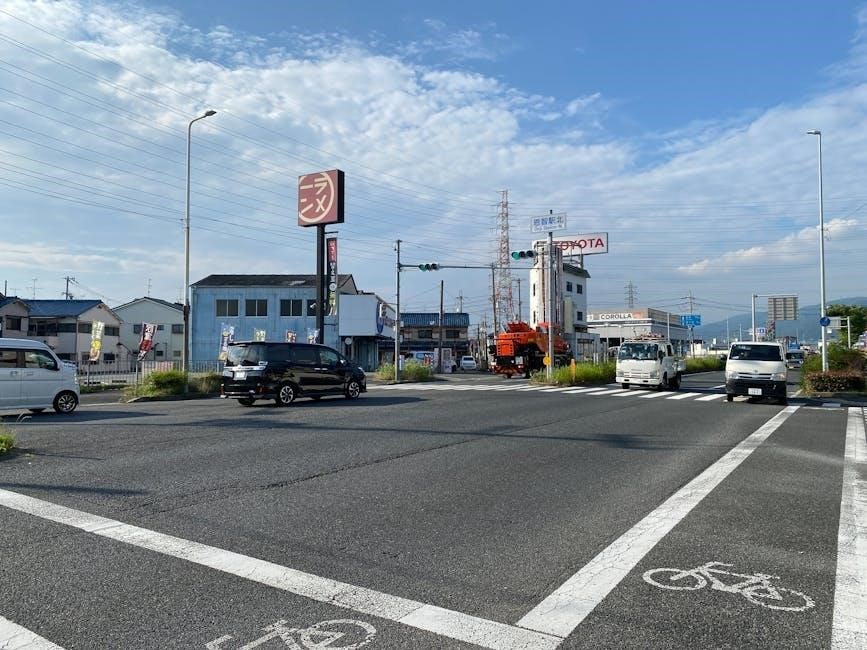chapter 6 traffic signs manual

Chapter 6 provides essential guidance on traffic control measures, focusing on standardized signs, signals, and road markings to ensure safety and efficiency for all road users.
1.1 Purpose and Scope of Chapter 6
Chapter 6 of the Traffic Signs Manual focuses on traffic control measures, providing detailed guidance on the design, placement, and use of traffic signs and signals. Its purpose is to ensure consistency and clarity in traffic management, promoting safety and efficiency for all road users. The scope covers traffic signals, pedestrian crossings, and temporary arrangements, offering technical advice for urban and rural areas. It emphasizes compliance with regulations and standards, particularly for roads with speed limits of 40 mph and under. The chapter is essential for professionals designing and implementing traffic control systems across the UK.
1.2 Key Concepts and Terminology
Chapter 6 introduces key concepts such as traffic signals, pedestrian crossings, and road markings, emphasizing their roles in maintaining order and safety. Terminology includes “wig-wag signals,” “tram signals,” and “lane control signals,” which are essential for designing efficient junctions. The chapter also defines standardized signs, highlighting their importance in clear communication. Compliance with UK traffic regulations and European norms is stressed, ensuring consistency across regions. These concepts and terms form the foundation for understanding modern traffic control systems, aiding professionals in implementing effective solutions.

Traffic Control Measures
Chapter 6 outlines traffic control measures, including traffic signals, pedestrian crossings, and standardized signs, ensuring safe and efficient movement of all road users.
2.1 Overview of Traffic Control
Traffic control encompasses systems and devices to manage the flow of vehicles and pedestrians, ensuring safety and efficiency. It includes traffic signals, signs, and road markings to guide users. Effective traffic control coordinates signal timing, prioritizes movements, and minimizes congestion. It also addresses pedestrian safety through crossings and signals. The manual provides guidelines for designing and implementing these measures, adapting to urban and rural environments. Traffic control is essential for reducing accidents and ensuring smooth travel, especially in high-traffic areas. Proper planning and maintenance are crucial for its success. This section forms the foundation for understanding traffic management strategies.
2.2 Importance of Standardized Traffic Signs
Standardized traffic signs are vital for ensuring consistency and clarity in communication with road users. Uniform designs, symbols, and colors reduce confusion, enhancing safety and compliance with traffic laws. They provide instant recognition, aiding drivers in making quick decisions. Consistency across regions ensures seamless understanding for all users, regardless of location. Standardization also supports legal compliance, as deviations can lead to liability issues. By adhering to established norms, traffic signs effectively contribute to accident reduction and smoother traffic flow, forming a critical component of modern traffic control systems. Their importance cannot be overstated in maintaining order on the roads.
2;3 Design and Placement of Traffic Signs
The design and placement of traffic signs are critical for effective communication. Signs must be visible, legible, and standardized to ensure clarity. Factors like size, color, and symbol placement are tailored to meet visibility needs. Placement locations are carefully selected to provide adequate notice, especially at junctions and crossings. Compliance with regulations ensures consistency and legal adherence. Proper placement enhances safety, guiding road users seamlessly. Design elements, such as retroreflective materials, improve visibility at night. Regular maintenance is essential to uphold effectiveness. These principles ensure signs are functional and contribute to overall traffic safety and efficiency.

Traffic Signals and Pedestrian Crossings
Traffic signals and pedestrian crossings are vital for managing safe and efficient movement. They ensure clear communication and coordination between all road users, enhancing overall traffic flow and safety.
3.1 Design of Traffic Signal Junctions
The design of traffic signal junctions focuses on ensuring safety and efficiency, particularly in urban areas with speed limits of 40 mph and under. It provides detailed guidance on signal phasing, timing, and layout to minimize congestion and reduce accidents. The manual emphasizes the importance of clear visibility and standardized signaling, including wig-wag signals, tram signals, and lane control signals. Compliance with Traffic Signs Regulations and European norms is essential to maintain consistency and effectiveness in traffic management.
3.2 Types of Pedestrian Crossings
Chapter 6 details various types of pedestrian crossings, including zebra, pelican, and puffin crossings, each designed to enhance safety and visibility. Zebra crossings feature black and white stripes, while pelican and puffin crossings incorporate traffic signals. These designs ensure pedestrians can cross safely, with clear markings and signals guiding both drivers and walkers. The manual emphasizes the importance of standardized designs to maintain consistency and effectiveness across the UK, ensuring all road users understand and adhere to traffic rules. Proper implementation of these crossings is crucial for reducing accidents and improving urban mobility.
3.3 Integration of Traffic Signals and Crossings
Chapter 6 emphasizes the integration of traffic signals and pedestrian crossings to optimize traffic flow and safety. Synchronized signals ensure pedestrians and vehicles move efficiently, reducing congestion. The manual highlights the importance of clear signal timing and visibility, especially at junctions with high pedestrian activity. Features like countdown timers and audible signals enhance accessibility for all users. Proper integration ensures smooth transitions between pedestrian phases and traffic light cycles, minimizing delays and potential conflicts. This coordinated approach aligns with broader traffic management goals, fostering safer and more organized road environments.

Temporary Traffic Arrangements
Chapter 6 addresses temporary traffic management, including road works and diversion signs, to ensure safety and minimize disruption during construction or unexpected incidents.
4.1 Temporary Traffic Management
Chapter 6 provides guidance on managing temporary traffic arrangements, ensuring safety and efficiency during roadworks or events. It covers the use of diversion signs, road work signs, and pedestrian crossings. The section emphasizes compliance with traffic regulations and standards to maintain order and minimize disruptions. Temporary traffic management plans are tailored for specific conditions, such as urban areas with lower speed limits. Professionals are advised to follow best practices for designing and implementing temporary traffic control measures, ensuring clear communication to all road users.
4.2 Road Works and Diversion Signs
Chapter 6 emphasizes the importance of clear and standardized signage for road works and diversions. Diversion signs are crucial to guide drivers safely around construction zones or closed roads. These signs must comply with traffic regulations to ensure visibility and clarity. The Manual provides detailed guidance on the design, placement, and sequencing of diversion signs to minimize confusion and maintain traffic flow. Road works signs, such as “Road Ahead Closed” or “Diversion,” are essential for advance warning and directional guidance. Proper signage ensures road user safety and reduces disruptions during maintenance or construction activities.
4.3 Safety Measures for Temporary Situations
Chapter 6 highlights the critical importance of implementing robust safety measures during temporary traffic arrangements. These measures ensure the protection of road workers and users in dynamic environments. The Manual emphasizes the use of appropriate signage, barriers, and lighting to maintain visibility and safety. Temporary situations, such as roadworks or emergencies, require clear communication to road users through standardized signs and markings. Compliance with safety regulations is non-negotiable to prevent accidents and ensure smooth traffic flow. Regular monitoring and adaptation of safety measures are also stressed to address evolving conditions effectively.

Road Markings and Their Role in Traffic Control
Road markings play a crucial role in traffic control by guiding drivers, separating traffic flows, and enforcing rules, thereby enhancing safety and maintaining order on roads.
5.1 Types of Road Markings
Road markings are categorized into longitudinal and transverse types. Longitudinal markings, such as center lines and edge lines, separate traffic flows and guide drivers. Transverse markings, like stop lines and pedestrian crossings, regulate traffic movement. These markings are designed to be highly visible, using reflective materials and contrasting colors. They play a vital role in enforcing traffic rules, reducing accidents, and maintaining smooth traffic flow. Compliance with these markings is essential for road safety, ensuring drivers adhere to traffic regulations. Effective road markings are a cornerstone of efficient traffic control systems.
- Longitudinal markings
- Transverse markings
- Specialized markings for pedestrian crossings
- Lane dividers
5.2 Compliance with Traffic Signs Regulations
Compliance with Traffic Signs Regulations is critical for maintaining road safety and order. The Traffic Signs Regulations and General Directions 2016 (TSRGD) prescribe the design and use of traffic signs and road markings in the UK. These regulations ensure consistency across England, Wales, Scotland, and Northern Ireland. Compliance involves using approved symbols, colors, and layouts, as well as proper placement of signs and markings. Non-compliance can lead to legal penalties and increased risks of accidents. Adhering to these standards ensures clear communication with road users, promoting safe and efficient traffic flow.
- Adherence to TSRGD 2016 standards
- Consistent design and placement
- Legal requirements for road safety
5.3 Maintenance of Road Markings
Maintenance of road markings is vital for ensuring visibility, safety, and traffic efficiency. Regular inspections and upkeep are necessary to address fading, wear, and damage caused by weather or heavy use. This includes repainting lines, replacing reflective materials, and cleaning surfaces to maintain clarity. Proper maintenance ensures that road users can easily understand lane divisions, directional guidance, and hazard warnings. Adhering to the standards outlined in the Traffic Signs Manual guarantees that road markings remain effective and consistent, supporting overall traffic safety and order.
- Regular inspections to identify maintenance needs
- Repainting and refurbishing worn markings
- Ensuring visibility and clarity for road users
Legal and Regulatory Framework
Chapter 6 outlines the legal framework governing traffic signs, emphasizing compliance with the Traffic Signs Regulations and General Directions 2016 to ensure safety and consistency.
6.1 Traffic Signs Regulations and General Directions 2016
The Traffic Signs Regulations and General Directions 2016 (TSRGD) provide legal standards for traffic signs in England, detailing designs, placements, and conditions for lawful use. These regulations ensure consistency across the UK, aligning with European norms while incorporating British-specific requirements. The TSRGD covers various sign categories, including warning, regulatory, and informatory signs, and specifies the use of symbols, colors, and road markings. Compliance with these regulations is mandatory for local authorities and contractors to maintain road safety and efficiency, with non-compliance leading to legal implications. This framework is essential for designing and implementing effective traffic control measures.
6.2 Compliance with European Norms
UK traffic signs largely align with European norms, ensuring consistency and safety across borders. While Britain retains some unique signs, many designs, such as warning and regulatory signs, follow European standards. This alignment facilitates recognition for international drivers and maintains harmonized road safety practices. Compliance with European norms enhances the clarity and effectiveness of traffic signage, contributing to reduced accidents and smoother traffic flow. This dual approach ensures the UK’s traffic signs are both locally relevant and internationally understood, upholding safety and efficiency for all road users.
6.3 Legal Implications of Non-Compliance
Non-compliance with traffic sign regulations can lead to legal consequences, including fines and penalties. Improperly designed or placed signs may not be enforceable under traffic laws, undermining their effectiveness. Authorities can take enforcement action against non-compliant parties, and failure to adhere to standards may result in liability for accidents caused by unclear or misleading signage. Compliance with the Traffic Signs Regulations and General Directions 2016 is essential to avoid legal repercussions and ensure road safety. Proper adherence to these standards safeguards both road users and those responsible for traffic management.

Best Practices for Traffic Sign Design
Ensure clarity and visibility by using standardized designs, consistent colors, and recognizable symbols. Maintain simplicity to communicate effectively to all road users, day and night.
7.1 Clarity and Visibility of Signs
Clarity and visibility are paramount in traffic sign design. Signs must be easily readable from a distance, using high-contrast colors and legible fonts. Reflective materials enhance visibility at night or in low-light conditions. Ensure consistent sizing and placement to avoid confusion. Proper spacing and unobstructed views are critical for driver comprehension. Simple, universal symbols and concise wording help reduce reaction times. Regular maintenance ensures signs remain visible and free from wear. These principles ensure effective communication, reducing accidents and improving traffic flow.
7.2 Consistency in Design Across Regions
Consistency in traffic sign design across regions is vital for driver familiarity and safety. Uniformity ensures that road users recognize and understand signs effortlessly, regardless of location. Standardized symbols, colors, and layouts reduce confusion and enhance compliance. Regional variations are minimized to maintain a cohesive visual language, aligning with national and international standards. This consistency aids drivers navigating unfamiliar areas, as they rely on recognizable patterns. Regular updates and adherence to central guidelines ensure harmony across all regions, fostering a seamless driving experience and improving overall traffic safety; Compliance with these standards is essential for effective traffic management.
7.3 Use of Symbols and Colors
The use of symbols and colors in traffic signs is critical for clear communication. Symbols are standardized to convey specific messages instantly, while colors enhance visibility and differentiate sign types. Red is often used for prohibitions, blue for informational signs, and green for directional guidance. Consistent color schemes ensure uniformity across regions, aiding driver recognition. Symbols are designed to be universally understood, avoiding text dependency. This approach ensures that signs are easily comprehensible, even in diverse linguistic and cultural contexts, thereby improving road safety and user compliance with traffic regulations effectively worldwide. Clarity is paramount in design to prevent accidents and ensure smooth traffic flow.

Case Studies and Real-World Applications
Case studies highlight successful traffic control implementations, showcasing how standardized signs and signals improve safety and efficiency in urban and rural areas, reducing accidents and enhancing flow.
8.1 Successful Implementation of Traffic Control Measures
Real-world applications demonstrate how effective traffic control measures enhance safety and efficiency. For instance, urban areas with well-designed traffic signals and clear pedestrian crossings have seen reduced accidents and improved flow. Successful implementations often involve integrating standardized signs with intelligent systems, ensuring consistency across regions. Case studies highlight the importance of adherence to Chapter 6 guidelines, such as proper sign placement and visibility. These examples provide valuable insights, showing how strategic traffic management can significantly benefit road users and communities, making transportation networks safer and more reliable.
8.2 Lessons Learned from Urban and Rural Areas
Urban and rural areas present unique challenges for traffic control. Urban zones benefit from advanced signaling and clear pedestrian pathways to manage high traffic volumes. Rural areas, with lower traffic but higher speeds, require highly visible signs and markings to enhance safety. Both settings highlight the importance of adaptability in design and implementation. Lessons learned emphasize the need for standardized signs to maintain consistency, regardless of location. These insights from diverse environments help shape effective traffic management strategies, ensuring safety and efficiency for all road users while addressing specific regional needs and challenges.

8.3 Innovative Solutions for Traffic Management
Innovative solutions in traffic management include smart traffic signals and dynamic signage that adapt to real-time conditions, improving flow and safety. Integration of data analytics and IoT devices enables predictive traffic management. Pedestrian-friendly technologies, such as smart crossings, enhance safety. Green wave systems for cyclists reduce congestion. These innovations align with the manual’s goals, ensuring efficient and safe traffic control. By leveraging technology, urban and rural areas can address unique challenges, creating smarter, more responsive transportation networks. These solutions are key to modernizing traffic management systems worldwide, ensuring sustainability and adaptability for future needs.
Chapter 6 emphasizes the importance of standardized traffic control measures for safety and efficiency, paving the way for future innovations in traffic management and technological integration.

9.1 Summary of Key Takeaways
Chapter 6 of the Traffic Signs Manual underscores the critical role of standardized traffic control measures in ensuring road safety and efficiency. It highlights the importance of clear, consistent, and compliant signage, as well as the integration of traffic signals and pedestrian crossings. The chapter emphasizes adherence to regulatory frameworks and the need for continuous improvement in design and placement. By focusing on these elements, Chapter 6 provides a comprehensive guide for professionals to create safer and more efficient road environments, balancing the needs of all road users while preparing for future challenges in traffic management.
9.2 Future Trends in Traffic Control
Future trends in traffic control will likely focus on smart technologies and data-driven solutions to enhance efficiency and safety. Intelligent traffic signals, adaptive real-time systems, and integration with connected vehicles are expected to become more prevalent. There will also be a greater emphasis on sustainability, such as energy-efficient signage and renewable power sources. Advances in data analytics will enable better prediction of traffic patterns and optimization of traffic light timings. Additionally, the use of IoT devices and AI will improve decision-making for traffic management, ensuring smoother and safer movement of all road users in urban and rural areas alike.
9.3 Continuous Improvement in Traffic Safety

Continuous improvement in traffic safety requires ongoing efforts to enhance road user behavior, infrastructure, and enforcement. Public awareness campaigns, stricter enforcement of traffic laws, and regular maintenance of traffic signs and markings are critical. Technological advancements, such as smart traffic systems and real-time data analysis, will play a key role in identifying and addressing safety issues. By prioritizing proactive measures and adapting to emerging challenges, the goal is to reduce accidents and create a safer environment for all road users, fostering a culture of safety and responsibility.
Leave a Reply
You must be logged in to post a comment.